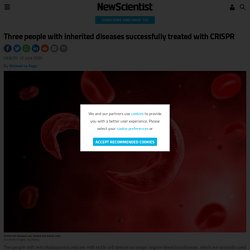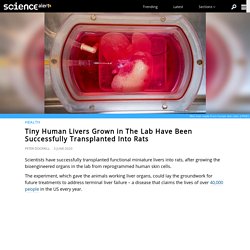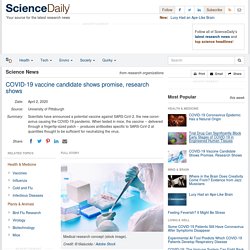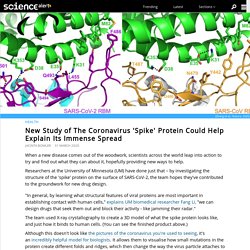

Meat Without Animals: The Future Of Food. Singapore startup Shiok Meats re-creates shrimp — in the lab.
Devil Comeback: Chris Hemsworth helps Aussie Ark return Tasmanian devils to mainland Australia for the first time in 3000 years. FOR the first time in 3000 years, the Tasmanian devil is back in the wild on mainland Australia, an historic moment that is critical to rewild Australia, the country with the world's worst mammal extinction rate.

Aussie Ark, in partnership with Global Wildlife Conservation and WildArk, recently released 11 Tasmanian devils into a 400-hectare (nearly 1,000 acres) wildlife sanctuary on Barrington Tops. Actors Elsa Pataky and Chris Hemsworth, who is a WildArk supporter, helped release some of the animals, following a successful assisted trial release with 15 Tasmanian devils. Twenty-six total devils now call the wild of mainland Australia home. The Great Acceleration. Meet Chuck - A Diabetes Alert Dog at HSBC. How dogs can sniff out diabetes. Three people with inherited diseases successfully treated with CRISPR. By Michael Le Page Stocktrek Images, Inc/Alamy Two people with beta thalassaemia and one with sickle cell disease no longer require blood transfusions, which are normally used to treat severe forms of these inherited diseases, after their bone marrow stem cells were gene-edited with CRISPR.

Result of this ongoing trial, which is the first to use CRISPR to treat inherited genetic disorders, were announced today at a virtual meeting of the European Hematology Association. “The preliminary results… demonstrate, in essence, a functional cure for patients with beta thalassaemia and sickle cell disease,” team member Haydar Frangoul at Sarah Cannon Research Institute in Nashville, Tennessee, said in a statement. Advertisement Beta thalassaemia and sickle cell disease are conditions caused by mutations that affect haemoglobin, the protein that carries oxygen in red blood cells.
Tiny Human Livers Grown in The Lab Have Been Successfully Transplanted Into Rats. Scientists have successfully transplanted functional miniature livers into rats, after growing the bioengineered organs in the lab from reprogrammed human skin cells.

The experiment, which gave the animals working liver organs, could lay the groundwork for future treatments to address terminal liver failure – a disease that claims the lives of over 40,000 people in the US every year. While there's still a lot of work to be done before the technique can directly aid human patients, the researchers say their proof of concept may help underpin a future alternative to liver transplants, which are often incredibly expensive procedures to perform, in addition to being strictly limited by donor supply. "The long-term goal is to create organs that can replace organ donation, but in the near future, I see this as a bridge to transplant," explains pathologist Alejandro Soto-Gutiérrez from the University of Pittsburgh.
Coronavirus vaccine update: How far along is the research? Oxford University Just Injected The First Participants in a COVID-19 Vaccine Trial. Oxford University is launching a human trial of a potential coronavirus vaccine, with the daunting aim of making a successful jab available to the public later this year.

Of the more than 100 research projects around the world to find a vaccine - described by the United Nations as the only route back to "normality" - seven are currently in clinical trials, according to the London School of Hygiene and Tropical Medicine. Such trials are already underway in China and the United States and are due to begin at the end of this month in Germany, where the federal vaccine authority gave the green light on Wednesday. The British government strongly supports Oxford University's work, and the first human trials were to start on Thursday, Health Minister Matt Hancock said.
He hailed the "promising development", pointing out that it would normally take "years" to reach such a stage of vaccine development. Ten participants will receive two doses of the experimental vaccine, four weeks apart. Scientists Are Using The Measles Vaccine to Develop a 'Trojan Horse' Against COVID-19. US Just Started The First Human Trial of a Vaccine For The New Coronavirus. The first human trial to evaluate a candidate vaccine against the new coronavirus has begun in Seattle, US health officials said Monday, raising hopes in the global fight against the disease.

But it may be another year to 18 months before it becomes available, once it has passed more trial phases to prove it works and is safe. Search speeds up for vaccine against the new coronavirus. A mystery illness emerged in China late last December.

As word of its spread got out, researchers at Inovio Pharmaceuticals paid close attention. This was even before anyone knew what was making people sick — a new coronavirus. Vaccine candidate against SARS-CoV-2 being tested. South Australian researchers working with Oracle Cloud technology and vaccine technology developed by local company Vaxine Pty Ltd are testing a vaccine candidate against the SARS-CoV-2 coronavirus responsible for the COVID-19 pandemic.

The team is headed by Nikolai Petrovsky, Flinders University Professor and Research Director at Vaxine. His team has tapped Oracle for technical collaboration, access to an expanded research community, and cloud infrastructure that helped enable the rapid design of the novel COVID-19 vaccine candidate. "The vaccine has progressed into animal testing in the US and, once we confirm it is safe and effective, will then be advanced into human trials," says Professor Petrovsky -- stressing expectations shouldn't be elevated until all testing is completed. COVID-19 vaccine candidate shows promise, research shows. University of Pittsburgh School of Medicine scientists today announced a potential vaccine against SARS-CoV-2, the new coronavirus causing the COVID-19 pandemic.

When tested in mice, the vaccine, delivered through a fingertip-sized patch, produces antibodies specific to SARS-CoV-2 at quantities thought to be sufficient for neutralizing the virus. The paper appeared today in EBioMedicine, which is published by The Lancet, and is the first study to be published after critique from fellow scientists at outside institutions that describes a candidate vaccine for COVID-19. The researchers were able to act quickly because they had already laid the groundwork during earlier coronavirus epidemics. "We had previous experience on SARS-CoV in 2003 and MERS-CoV in 2014. These two viruses, which are closely related to SARS-CoV-2, teach us that a particular protein, called a spike protein, is important for inducing immunity against the virus. The system also is highly scalable. Sciencealert. When a new disease comes out of the woodwork, scientists across the world leap into action to try and find out what they can about it, hopefully providing new ways to help.

Researchers at the University of Minnesota (UM) have done just that – by investigating the structure of the 'spike' protein on the surface of SARS-CoV-2, the team hopes they've contributed to the groundwork for new drug design. "In general, by learning what structural features of viral proteins are most important in establishing contact with human cells," explains UM biomedical researcher Fang Li, "we can design drugs that seek them out and block their activity - like jamming their radar.
" The team used X-ray crystallography to create a 3D model of what the spike protein looks like, and just how it binds to human cells. (You can see the finished product above.)
Scientists program cells to carry out gene-guided construction projects. Stanford researchers have developed a technique that reprograms cells to use synthetic materials, provided by the scientists, to build artificial structures able to carry out functions inside the body.

"We turned cells into chemical engineers of a sort, that use materials we provide to construct functional polymers that change their behaviors in specific ways," said Karl Deisseroth, professor of bioengineering and of psychiatry and behavioral sciences, who co-led the work. In the March 20 edition of Science, the researchers explain how they developed genetically targeted chemical assembly, or GTCA, and used the new method to build artificial structures on mammalian brain cells and on neurons in the tiny worm called C. elegans.
Scientists program cells to carry out gene-guided construction projects. In World First, CRISPR Used on Patient's Eye in Attempt to Cure Genetic Blindness. For the first time, doctors have attempted to cure blindness by gene-hacking a patient with CRISPR technology. A team from Oregon Health & Science Institute injected three droplets of fluid that delivered the CRISPR DNA fragments directly into a patient's eyeball, The Associated Press reports, in hopes that it will reverse a rare genetic condition called Leber congenital amaurosis, which causes blindness early in childhood. "We literally have the potential to take people who are essentially blind and make them see," Charles Albright, chief scientific officer of Editas Medicine, told the AP. Editas is one of the biotech companies that actually developed the treatment.
Not bot, not beast: scientists create first ever living, programmable organism. A remarkable combination of artificial intelligence (AI) and biology has produced the world’s first “living robots”. This week, a research team of roboticists and scientists published their recipe for making a new lifeform called xenobots from stem cells. The term “xeno” comes from the frog cells (Xenopus laevis) used to make them. One of the researchers described the creation as “neither a traditional robot nor a known species of animal”, but a “new class of artifact: a living, programmable organism”.
A Terminally Ill British Scientist Aims to Be The Most 'Cybernetic' Human Ever Created. British roboticist Peter Scott-Morgan doesn't want you to see him as a man who died from a neurodegenerative disease. He wants to become Peter 2.0 – the most advanced cyborg ever. There's an extensive list of medical devices already helping him breathe, feed, and communicate; those technologies are set to grow in the near future. But, according to Scott-Morgan, this isn't about staving off death; it's about evolving.
"Yes, I know, this all sounds like science fiction," he admits on his blog. "But some of the top brains in the world, in an alliance of some of the most powerful hi-tech megacorporations, are set to make it happen – by the end of this year. " Ancient Ice Has Revealed The CO2 Cycle of Earth Going Back Nearly 2 Million Years. After more than two years of analysis, the oldest complete ice core has served up a reliable snapshot of our planet's atmosphere from nearly 2 million years ago. And the results are not what many expected. We know that roughly 1 million years ago, the cycle of Earth's ice ages suddenly shifted, with deeper and longer freezes occurring only every 100,000 years, instead of once every 40,000 years. 'Overzealous' Regulation of GM Crops Costs Children's Lives Worldwide, Says New Book.
Gene-Hacking Mosquitoes to Be Infertile Backfired Spectacularly. New Blood Test Could Help Predict One's Risk of Death in The Next 10 Years. Nobody can see into the future, but the blood that courses through your veins may hold some important secrets about your future health – or lack thereof. In a new study, researchers have identified 14 biomarkers in human blood that are linked with all-cause mortality, and which may help scientists to predict risk of death in patients within five to 10 years.
Scientists Just Developed an Unnerving Method For Selecting The Sex of Mouse Sperm. Human semen, If you separated it out, would on average hold a 50/50 mix of sex chromosomes - half of the sperm bearing the Y chromosome, and half the X chromosome. UK scientists test breathalyser for detecting early cancers. Scientists Are Genetically Engineering Plants to Store Carbon Deeper in The Earth. Male Tassie devils hit hardest by second type of transmissible cancer - Science News - ABC News. Male Tasmanian devils are hardest hit by a second type of transmissible cancer, which is putting even more pressure on the endangered species, a new study has found.
Key points: Mysterious 'Cat-Fox' May Be a Newly Discovered Species, Researchers Say. Scientists Think They Finally Know What Happens in The Skin When You Have Eczema.
This Is What Happens to Your Body in Mount Everest's Overcrowded 'Death Zone' It's Official: Malaysia's Last Male Sumatran Rhino Is Dead. With the death of Tam, the last male Sumatran rhino in Malaysia, another nail has been hammered into the species' coffin. Now, only one female Sumatran rhino named Iman remains in the country, ending efforts to produce offspring. Back to (nucleic) bases—Studying DNA aboard the International Space Station.
Medicinal Herbs Used in The US Civil War Could Help Us Kill Drug-Resistant Bacteria. Amazing Plastic-Eating Microbes Could Help Clean Up The Terrible Trash in Our Oceans. Scientists Working With Mice Just Discovered How Cells Can Stop The Spread of Cancer. Germany Proposes Massive Fines For Parents Who Don't Vaccinate Kids Against Measles. Brilliant Gene Therapy Has Cured Babies With Rare And Dangerous 'Bubble Boy' Disease. Newly Invented Application of CRISPR Could Actually Cure Herpes One Day. Gene-Hacked Bacteria Are Making Spider Silk So Strong It Could Build Space Suits. More than a hunch: identifying Richard III with DNA. Faulty Cell Cleanup in The Brain Could Contribute to Alzheimer's, Study Shows. Nobel Prize Winner Reportedly Knew About Gene-Edited Babies Months Before It Was Announced. Hens that lay human proteins in eggs offer future therapy hope. Surprise Discovery Reveals an Ancient, Extinct Giant Hidden Among Ivory in Cambodia.
'Designer' babies won't be common anytime soon – despite recent CRISPR twins. 'Designer' babies won't be common anytime soon – despite recent CRISPR twins. Scientists Successfully Made Sheep-Human Hybrids in 2018. One test to diagnose them all: researchers exploit cancers' unique DNA signature. Scientists Develop a Spiky Eye Patch That Injects Drugs Straight Into The Eye. Something Unexpected Has Been Happening to Plants in The Arctic as It Gets Warmer. Pharmaceutical Companies Are Backing Away From a Threat That Could Kill 10 Million a Year by 2050. Scientists Are Fitting Rhinos' Horns With Spy Cameras And Alarms to Catch Poachers. New weapon against the reef eaters. A Terminator-Style Kill-Bot Is About to Start Wreaking Carnage on The Great Barrier Reef. New Way of Measuring Biodiversity Could Help Protect Earth's Most Vulnerable Species.
Robots ready to start killing crown-of-thorns starfish on Great Barrier Reef. Robot drone could protect Great Barrier Reef by killing crown-of-thorns starfish. The amazing significance of what a mother-to-be eats. Cooling babies 'helps reduce longer-term brain damage' Just How Dirty Is Your Office Desk? It's Worse Than You Think. We need a bank of DNA from dirt and water to protect Australia's environment. Theconversation. GM Potato Can Help Cut Pesticide Use by Up to 90 Percent, Study Shows. Baby genes to be mapped at birth in medical first. Should Babies Have Their Genomes Sequenced?
This scientist says he's invented a water bottle that fully decomposes in just 3 weeks. A home DNA test kit for humans found this golden retriever would make a great cyclist. Cancer cells can go mysteriously dormant for years, and scientists are beginning to understand why. Scientists have accidentally created a mutant enzyme that eats plastic waste. A simple poop transplant could fix a debilitating brain disease, study shows. Theconversation. Scientists find a crucial new role for DNA we once considered junk. This new treatment could heal tooth cavities without any fillings. Essentials Concept Video – Protein Synthesis. This 'injectable bandage' made from seaweed could stop internal bleeding in minutes. A huge gene discovery is set to improve the lives of people with blood disorders. Babies who get more cuddles seem to have their genetics changed for years afterwards. Viagra turns out to have a totally unexpected side effect that could save thousands of lives.
Snorting ketamine may not be the best way to treat depression, study shows. Uk.businessinsider. Drones revolutionize ecological monitoring. Sticky gels turn insect-sized drones into artificial pollinators. Type 2 diabetes was misdiagnosed all along, it could actually be several diseases. An Alzheimer's drug has been shown to help teeth repair cavities naturally. News in Science - Species form when fish booted out of home - 24/08/2004. Genetically edited pigs raise hopes for transplanting animal organs into humans. Genome 10K: A new ark. Grapevines are more drought-tolerant than thought. Plastic pollution increases risk of devastating disease in corals. Somewhere in the brain is a storage device for memories. Theconversation. Theconversation. Australia has 2,000 missing persons and 500 unidentified human remains – a dedicated lab could find matches. It's Premature to Conclude That Cell Phones Cause Cancer in Humans.